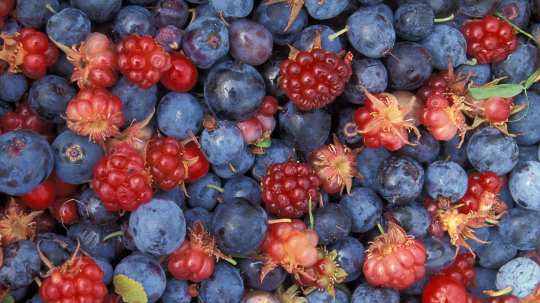
In an average year, we will can over 100 jars of homemade goodness, including tomatoes, pickles, applesauce, peaches and strawberry preserves. We have also canned more difficult things like corn and meat, which require a bit of extra care and more than a simple water bath.
We also have a closetful of root-cellared vegetables, like potatoes and squashes, and our homebrew. Three or four dozen heads of garlic from our garden hang in the kitchen. Our freezer is full of the chickens we raised, and the cow-share and pig-share we bought.
The common belief among the general public seems to be that store-bought food will last longer, which probably is not true. While some might be perfectly content to eat store-bought pork-n-beans from 1999, very few people would be comfortable eating home-canned strawberry jam made that same year — even though the latter is probably a good deal safer and a whole lot healthier.
Hoarding: The Fear of Going Hungry
Although most present-day Westerners have never experienced true hunger, let alone real famine, it is always in the back of our minds how easily it could happen to us. The pre-colonial era in Europe is depicted as one of deprivation and eking out an existence, and anyone with a standard public education was regaled with images and stories of the worldwide Great Depression during the 1930s. Those of us who were born during the Vietnam War Era recall the stark images of famine in Ethiopia.
Get The Latest By Email
Those who have not been negatively impacted by the economic downturn have some, perhaps more real, concerns, like weather-related crop failures, food riots and rising food costs, which only serve to increase our worry. These have resulted in a great temptation to succumb to our fear of going hungry and take all that we can get, storing it just in case.
The fact is that the potential for famine is ingrained in our agrarian culture. In the Judeo-Christian culture, this is an oft-discussed topic, starting at the very beginning with Joseph in Genesis, who won the Egyptian pharaoh’s favor by warning of a seven-year famine and proved his worthiness to be remembered through history as a Prophet. Famine is very much a part of agrarian societies because crops fail, and when one is dependent on a particular food crop for sustenance, failure is inevitable.
Foraging: A More Secure Way of Life
Life, for foragers, can be more secure for the simple fact that they understand crop failures happen. Thus, we learn not to depend wholly on one type of food, because we recognize all sorts of variables, that we cannot control, will affect how well a particular plant or animal grows.
For example, what might be to us minor fluctuations in temperature can ruin an entire years’ worth of maple syrup. When the buds start to form leaves, usually when the nights start to get above freezing, the sugaring season is over. We have had years where the season was two months long, and other years when it was three weeks. Since we cannot control the weather, and there is simply no chemical we know of that can make the trees produce better in spite of the weather, if we were wholly dependent on maple syrup, we would be in trouble.
It goes further though. It is not just that the weather will affect how well that plant produces, but that we can cause problems if we are too dependent on that one plant. Remember that we all have a tendency to want to take as much as we can get, but doing so as a forager could be devastating.
When tapping trees, for instance, it is important to pay attention to the size of the tree. While the sap from any maple can be made into syrup, tapping a too young tree, or putting too many taps into a larger tree can kill the tree. Dead trees do not give sap.
Sharing with Nature: The Forager's Rule of Thirds
There is a beautiful land trust area where we have enjoyed the generous bounty of Mother Nature. Here we have found the most amazing crop of milkweed that we have ever seen. This is a wonderful and versatile plant, because so much of it is edible. Early in the season, the shoots are delicious as an asparagus-like vegetable. Later in the season, the buds are delicious chopped and added to quiche. The flowers can be battered and fried, and the pods can be steamed and eaten like green beans, or stuffed, like pasta shells.
Imagine, though, that some forager, giving in to the very human tendency to hoard, harvested every single early milkweed shoot that was available in this vast field? It would be a lovely treat for that one person for the entire year — milkweed shoots, like asparagus, can be blanched and frozen for use later. But what about everyone else? And here, we are not talking about other human foragers, who would surely be disappointed, too, but about the other creatures who depend on the milkweed? In particular, Monarch butterflies, who are already being devastated by habitat loss, would suffer.
In addition, if we were to harvest all of the milkweed shoots at the beginning of the season, we would eliminate the possibility of all the other wonderful ways to enjoy the plant. If there are no shoots, there will be no buds, no flowers and no pods.
When we forage, we follow — without fail — the Forager’s Rule of Thirds:
- Take one-third.
- Leave one-third for others.
- Leave one-third for the future.
When taking up to a third of the plants, we try to help the remainder to become healthier. We can do this not by razing the closest third available, but by selectively picking small plants that are being shaded or crowded out by other bigger plants. In helping to thin the plants out, we pick ones that do not appear as vigorous as those nearby but are still edible. This is similar to the native philosophy of hunting the old, least hardy-looking or weaker animals to keep the herd strong and virile.
Leaving one-third for others, including other species, provides for biodiversity in a given area. If we were to harvest all of the fruits from a particular stand of blueberries, for instance, some birds and animals, finding no food, would move to other areas to seek out a means to feed themselves. These species that have had to find food elsewhere may have provided something to the other local species, and without those animals, other dependent species may suffer. In the most extreme case, taking too much could cause an imbalance that threatens the entire ecosystem, including the plant that we came to harvest in the first place. At very least, it is simple courtesy to leave some behind for others to find.
The final third, or more, we leave to grow bigger and stronger to reproduce. If we fail here, there may be a much smaller offering, or no crop at all, in subsequent years. This vital part is the breeding stock for all future generations of that plant, or animal, species. If we devastate the entire population in this spot, at best we will have to find another place to harvest this food.
The Problems of Over-Harvesting
If enough people do this in enough places, we risk running species into extinction. We have seen this type of over-harvesting and hunting within the last hundred years or so. In the early 1900s, both whitetail deer and wild turkeys had been hunted nearly to oblivion in North America, because we as a culture did not follow these rules. Thankfully, we were able to reverse this, and populations have rebounded.
Depending on the plant, sometimes we do not even take a third at a time. We will often only take what we can reasonably use for one or two meals. We will eat one meal and preserve a second with the intention of returning for more later. Using the milkweed as an example, we might take only a shallow basketful of the early shoots. When the milkweed starts to bud, we might take a few from several plants, but always leave some on each plant, never harvesting one entirely.
If it is not a good year for that plant, that is if the plant does not seem to be growing very well, then we will take none at all. The lovely thing about foraging is that there are always alternatives. Unlike the grocery store, where the sale item is one choice for that price, in nature, there are usually plenty of options, and all of them are free. Perhaps not an exact one-for-one trade (like we may not get an asparagus-like plant if we cannot have milkweed), but in nature, there is a veritable smorgasbord of options.
©2013 Wendy Brown & Eric Brown. All Rights Reserved.
Reprinted with permission of the publisher,
New Society Publishers. http://newsociety.com
Article Source
 Browsing Nature's Aisles: A Year of Foraging for Wild Food in the Suburbs
Browsing Nature's Aisles: A Year of Foraging for Wild Food in the Suburbs
by Wendy and Eric Brown.
Click here for more info and/or to order this book on Amazon.
About the Authors
 Eric and Wendy Brown are suburban homesteaders growing roots (both literally and figuratively) in Southern Maine. They have been studying wild edibles for many years. Until 2005 their family was living the American Dream, complete with credit card debt, car payments and two mortgages. Concerns about the environment, Peak Oil, and the economy combined with a growing desire to live a more self-sufficient life caused them to reevaluate and redesign their lives. The result has been a transition from a completely dependent, consumerist lifestyle to one of living debt-free in a comfortable, more energy efficient home in a desirable location with a bountiful garden.
Eric and Wendy Brown are suburban homesteaders growing roots (both literally and figuratively) in Southern Maine. They have been studying wild edibles for many years. Until 2005 their family was living the American Dream, complete with credit card debt, car payments and two mortgages. Concerns about the environment, Peak Oil, and the economy combined with a growing desire to live a more self-sufficient life caused them to reevaluate and redesign their lives. The result has been a transition from a completely dependent, consumerist lifestyle to one of living debt-free in a comfortable, more energy efficient home in a desirable location with a bountiful garden.









